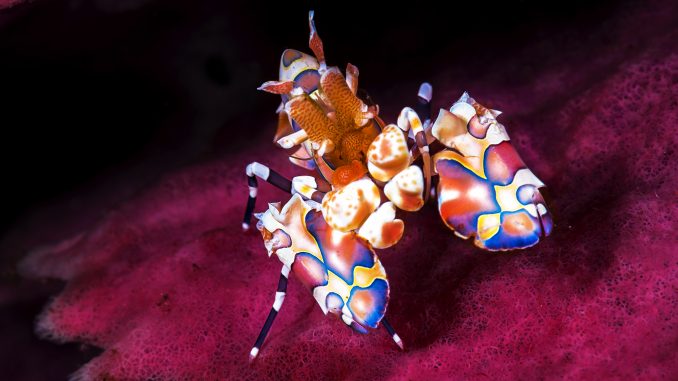
Many people are turning towards invertebrates as a way to spice up their aquariums. If you have a saltwater setup, Harlequin Shrimp are an excellent choice.
They are hard to resist; they have such a captivating appearance that you could fall in love with them at first sight. This isn’t something that all shrimp can boast.
An added bonus is that this species is great at removing pesky parasites such as Asterina Starfish. Many aquarists, therefore, choose Harlequin Shrimp to protect their corals.
These crustaceans are easy to care for if you are prepared to put up with their specific feeding habits. In return, you’ll get to watch some very interesting behaviors.
If you’re looking to learn more about Harlequin Shrimp, then you’ve come to the right place. We’ll explain everything you might need to know while caring for them.
TABLE OF CONTENTS
Harlequin Shrimp Facts & Overview

| Category | Rating |
| Care Level: | Intermediate |
| Temperament: | Territorial towards other shrimps only |
| Color Form: | Cream with red or purple spots |
| Lifespan: | Up to 7 years |
| Size: | Up to 2 inches |
| Diet: | Carnivores |
| Family: | Palaemonidae |
| Minimum Tank Size: | 10 gallons |
| Tank Set-Up: | Saltwater with plenty of caves |
| Compatibility: | Peaceful community with no other shrimps |
Harlequin Shrimp (or Painted Shrimp) is a saltwater species that lives in the Pacific and Indian Oceans.
Most people believe that there is only one species, called Hymenocera picta, making it the only member of the genus.
Others split Harlequin Shrimp into two species, based on the ocean they inhabit. In this scenario, H. picta is from the Central and East Pacific Ocean, whereas those from the West Pacific and Indian oceans are called Hymenocera elegans.
These crustaceans are part of the Palaemonidae family, which are usually characterized by their carnivorous feeding habits.
Members of this family have been found in all aquatic habitats except the deep sea.
Purchasing Harlequin Shrimp can be quite daunting for people who weren’t expecting the price. Individual shrimp can cost around $30, but prices vary and could be much higher. Larger shrimp tend to cost more.
That being said, they can live for up to 7 years in a healthy aquarium, so they won’t need replacing very often.
However, the price goes up further when you consider the cost of caring for them. Their diet can be quite expensive, which we’ll discuss later.
This is an attractive species that are simple to care for and is very interesting to watch.
If their beauty and behaviors aren’t enough to make you want some, then maybe their ability to protect corals will. Harlequin shrimp are excellent at removing parasites such as Asterina Starfish.
Typical Behavior
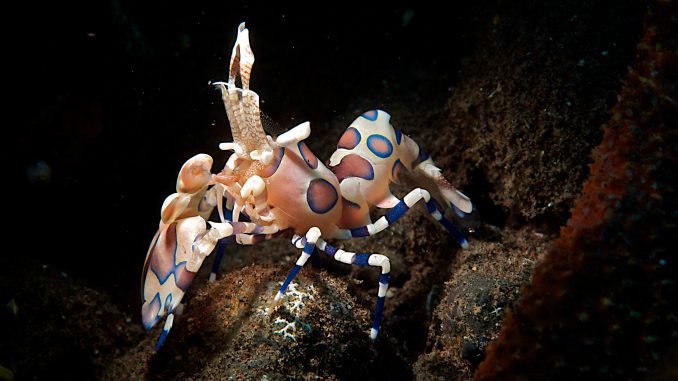
Initially, this species can be quite timid, hiding away for large parts of the day while they get used to their new environment.
They will probably find a dark cave and claim it, regularly returning there for shelter.
Aggression is often a problem in groups of this species, so they are generally kept alone or in a pair of one male and one female. This aggression can be directed towards other species of shrimp too.
Other than that, Harlequin Shrimp will remain peaceful and mostly ignore fish, though they will hide from threatening species.
These crustaceans form breeding pairs that will always remain close to each other. This isn’t just to produce offspring; it also ensures that they have a hunting partner.
Their hunting behaviors are fairly unique and are very interesting to watch unless you’re a starfish, which is their main food source. We’ll talk about how they hunt in the “Diet” section.
Another behavior to be aware of is molting. As a shrimp grows, it becomes too big for its shell, so it discards it and grows a bigger one.
You will spot the shells sitting on the substrate, don’t be tricked into thinking it is a dead shrimp.
Appearance
These are undeniably attractive creatures that give some of the most beautiful fish a run for their money.
In terms of body shape, Harlequin Shrimp have a classic shrimp appearance. The main differences include flattened claws and eyes, which can make them look a bit like a praying mantis.
On top of the head, next to the eyes, are sensory antennules. These are very important for helping them navigate and smell their prey when hunting.
Under the thorax are eight walking limbs called pereiopods. Under the abdomen are ten forked swimming limbs called pleopods.
The colors and patterns of this species are what really make them stand out. The main body is cream-colored, but they are covered in spots that can make them look fluorescent.
In the wild, the spots can be either red or purple, depending on where the shrimp is from. Red spots are characteristic of the Pacific Ocean whereas purple spots are more common in the Indian Ocean.
Both varieties are bred and sold in the aquarium trade, so you might have the luxury of picking your favorite. Most people just get the variety that is stocked closest to them though.
A fully grown individual usually reaches about 2 inches, but females are noticeably larger. Females also have larger colored spots under their tail and blue tips to the legs on their abdomen.
Habitat and Tank Conditions
As we have already mentioned, Harlequin Shrimp are naturally found in the Indian and Pacific Oceans. They can be found around the Clipperton, Galapagos, Gorgona, Malpelo, and Perlas islands.
Tropical islands like these are bordered by coral reefs, these shrimps live among the corals or the rubble piles just outside the reefs. They stick to coastal regions and are rarely found below a depth of 30m.
There are lots of caves and crevices in coral reefs and rubble piles, this species uses these as shelter, often returning to the same cave.
Once a breeding pair has been established, they will spend all of their time together, so they will share the same cave.
The water would be warm, alkaline, and well-lit, without strong currents. Since this is a marine habitat, there would also be a high salinity.
The key to keeping your Harlequin Shrimp healthy at home is to recreate their natural habitat. This is easy to do once you know their preferences.
Tank Conditions
When designing the layout of your tank, make sure there are plenty of hiding spots. Harlequin Shrimp are cave-dwellers and finding a cave will be their first though once added to the aquarium.
They need a cave to themselves (or with a mate) and will not be happy if tank mates try to claim it.
You can design the rest of the tank based on your own personal preferences, potentially mixing plants, corals, and decorations.
You need to set your heater between 82°F and 89°F. The pH should be 8.0-8.4 and the salinity should be 1.023-1.025.
The conditions of the water need to be maintained. Harlequin Shrimp are vulnerable to sudden changes in their environment.
Use a testing kit each week to ensure the water parameter are where they should be.
Avoid creating strong currents with your filter outlet or pumps. This would be stressful for your shrimp and they’d likely spend all day hiding in their cave.
A protein skimmer can be a useful addition to your aquarium. Parts of starfish can start decaying if not fully eaten, which can raise nitrate levels.
Standard aquarium lighting will be fine.
What Size Aquarium Do They Need?
Since these shrimps only reach 2 inches, they can be kept in setups as small as 10 gallons, if you have provided everything they need within.
A small tank makes it easy to limit water movement that could stress them out.
On the other hand, it can be difficult to maintain the water conditions of small aquariums. Harlequin Shrimp can be susceptible to environmental changes, so a larger tank is a safer option.
How Many Can Be Kept Per Gallon?
Most people keep just one individual. You should never have more than a pair – one male and one female.
Both sexes show aggression towards other members of the same sex.
Tank Mates
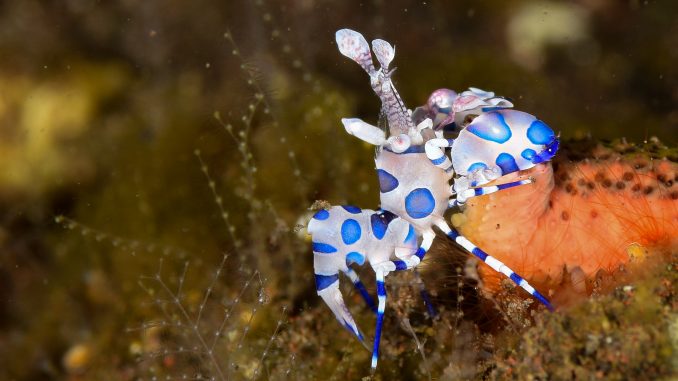
Harlequin Shrimp can make great additions to a community aquarium, but you can run into a few compatibility problems if you don’t do your research.
You should be avoiding fish that commonly eat shrimp or even any large/aggressive species. This rules out Wrasse, Lionfish, Puffers, and Damsels.
Crabs can be a threat to your shrimp too, such as Arrow Crabs and Decorator Crabs.
Some potential tank mate options include Panda Gobies, Scooter Blennies, Firefish, Clownfish, Cardinalfish, Tangs, and Watchman Gobies.
These shrimps mostly ignore fish, but other types of tank mates might be at risk.
Make sure they are the only shrimp species in the tank. Harlequins can be territorial and will start fights with other species.
Also, the only starfish or sea urchins you add to the aquarium should be intended as food, since they will soon be eaten.
Harlequin Shrimp can be kept in a reef tank because it won’t cause any damage to corals. In fact, they actually help corals because they eat the parasitic Asterina Starfish.
Keeping Harlequin Shrimp Together
This species is aggressive towards other members of the same sex, so males will fight males and females will fight females.
You cannot keep groups of Harlequin Shrimp together because of their territorial nature, just like you can’t keep them with other shrimp species.
The safest option is to keep a single individual in your aquarium. You can choose to keep a breeding pair of one male and one female if you’re looking to mate them.
Diet
This species has a specific diet, so you need to be familiar with it before purchasing your shrimp.
Most shrimp species have a varied diet because they are scavengers, so they eat whatever they come across. However, Harlequin Shrimp exclusively feed on starfish.
There are pros and cons to this.
One benefit that many people take advantage of is the fact they will eat the parasitic Asterina Starfish, which is useful for protecting corals.
Another benefit is being able to watch their very interesting feeding behaviors. Harlequin Shrimp can smell if a starfish is nearby, so they can’t hide.
Once they find one using chemical cues, they stand on top of a starfish to immobilize it and flip it over. They then take it back to their cave to feed on the tube feet. If you re keeping a pair, you’ll get to watch them do this together.
The main issue with using starfish is that feeding times can get a bit pricey. Chocolate Chip Starfish are usually the cheapest option, but they still cost $9-12.
One starfish could feed a single shrimp for about two weeks.
To avoid having to purchase lots of starfish for feeding, you could try establishing an Asterina population in your tank.
A second option is to start a starfish farm in a second tank. You can cut legs off of the starfish to feed your Harlequins, these should grow back.
Shrimp start feeding at the tip of a leg and head towards the center. Some starfish can intentionally remove their legs to escape, but your shrimp will be able to find them again.
Some people have reported that Harlequin Shrimp force-feed starfish algae to keep them alive while they’re gradually eaten.
Eating starfish can help shrimp to deter predators. Some starfish contain toxins that are then taken in by the shrimp, making them toxic to predators.
Care
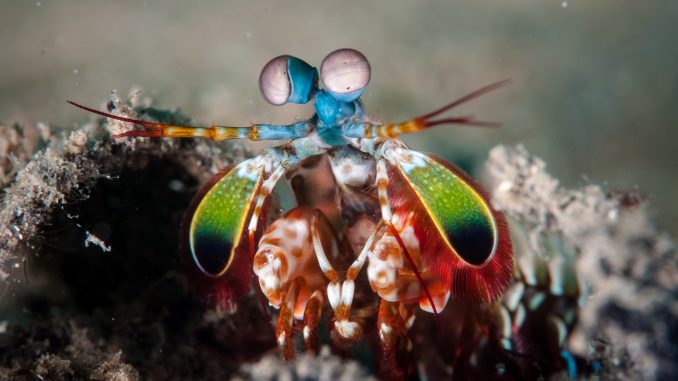
All aquatic pets need to be kept in a healthy environment if they are going to survive for a long time.
On a basic level, this means you must regularly clean the tank by performing water changes and wiping away excess algae.
Harlequin Shrimp are particularly sensitive to changes in the water around them, so it is even more important to maintain a healthy aquarium.
Use a testing kit to check the parameters of the water each week. This will help you to spot problems quickly so you can fix them before they affect your shrimp.
Before you ever add chemicals into your tank, check the label of the bottle for copper. Copper is toxic to these shrimp and most other invertebrates too.
Keep an eye out for discarded shells from molting that might be sitting on the substrate. Remove them for the tank once you spot them because they will decay and release chemicals into the water.
Be careful during the next few days because the shrimp will be vulnerable until their new shell grows and hardens. They will likely be hiding for a while after molting, keeping away from tank mates.
Breeding
Harlequin Shrimp form pairs to maximize their chances of producing offspring. Females in a pair actually tend to mature quicker. Pairing also helps with hunting and deterring predators.
While males do have a preferred female that they regularly return to, they will mate with every viable female they come across because their density in the wild is quite low, and this will increase reproduction rates.
When trying to breed this species, there should only be one male and one female in the tank, to avoid fights over territory and females.
Their environment must be perfect to trigger spawning behaviors, so keep the aquarium clean. Temperature is particularly important, keep it at the higher end of their preferred range (82°F-89°F).
Females become sexually mature after about 7 months. They will then start spawning after every molt, about once a month.
Around 1000 eggs can be fertilized at once; they are moved to the female’s abdomen 2 hours after fertilization.
After 12-18 days larvae will emerge from the eggs. You can tell this is about to happen because the eggs start turning transparent.
Raising the larvae can be difficult but it is possible. They go through 12 planktonic stages before the settlement stage at 5-6 weeks.
During the first couple of weeks, the larvae need very small foods, such as rotifer, microalgae, and brine shrimp eggs.
Artemia nauplii can be used as food after this. Once they reach the settlement stage, they will happily eat starfish.
A breeding tank shouldn’t contain any fish since they will probably eat the larvae while they are very small.
Are Harlequin Shrimp Suitable for your Aquarium?
Most people will find success when caring for Harlequin Shrimp. They aren’t particularly demanding and are inoffensive if you don’t have any other shrimp in the aquarium.
This means that if you maintain a clean tank then you should have some healthy shrimp for a long time.
The main thing that you must be prepared for is their diet. Using starfish as food can put people off, especially since they can get quite expensive to regularly purchase.
On the other hand, some aquarists love that they eat starfish because it deals with their parasite infestation.
Once you’ve added Harlequin Shrimp to your tank, you’ll be confident that you made the right decision. They are highly attractive and full of personality.
Have you added Harlequin Shrimp to your aquarium? Tell us your favorite thing about them in the comments below…

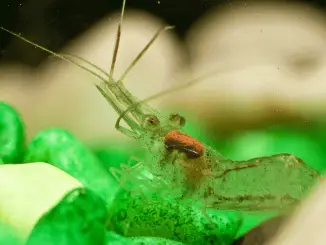
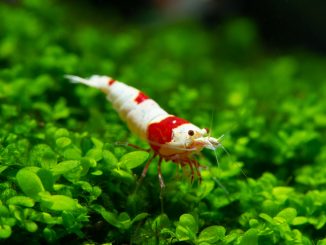
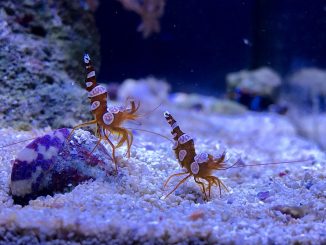
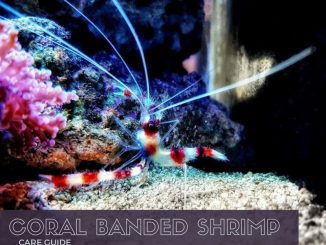
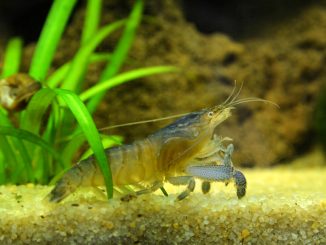
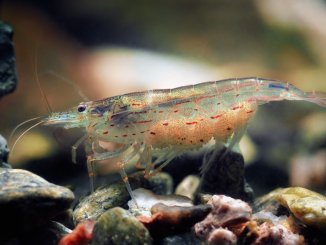
Be the first to comment